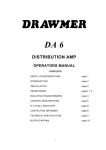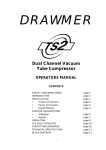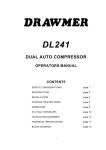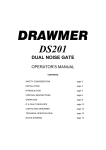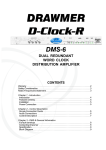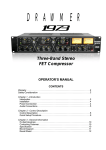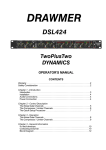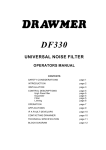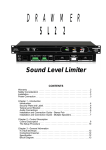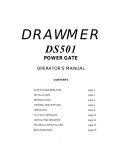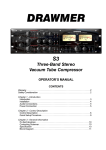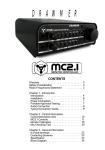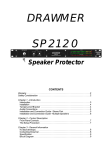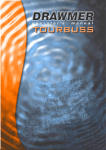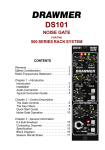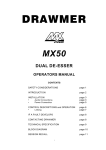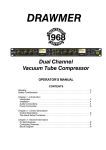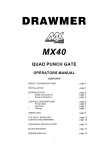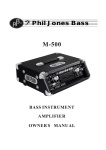Download User Manual
Transcript
DL441 QUAD COMPRESSOR LIMITER OPERATORS MANUAL CONTENTS SAFETY CONSIDERATIONS page 1 INTRODUCTION page 2 INSTALLATION page 3 CONTROL DESCRIPTIONS C Compressor C Peak Limit C Stereo Link page page page page OPERATION page 7 IF A FAULT DEVELOPS page 8 CONTACTING DRAWMER page 8 TECHNICAL SPECIFICATION page 9 BLOCK DIAGRAM page 10 i 5 5 6 6 COPYRIGHT This manual is copyrighted © 1997 by Drawmer Electronics, Ltd. With all rights reserved. Under copyright laws, this manual may not be duplicated in whole or in part without the written consent of Drawmer. ONE YEAR LIMITED WARRANTY Drawmer Electronics Ltd., warrants the Drawmer DL441 audio processor to conform substantially to the specifications of this manual for a period of one year from the original date of purchase when used in accordance with the specifications detailed in this manual. In the case of a valid warranty claim, your sole and exclusive remedy and Drawmer’s entire liability under any theory of liability will be to, at Drawmer’s discretion, repair or replace the product without charge, or, if not possible, to refund the purchase price to you. This warranty is not transferable. It applies only to the original purchaser of the product. For warranty service please call your local Drawmer dealer. Alternatively call Drawmer Electronics Ltd. at +44 (0)1709 527574. Then ship the defective product, with transportation and insurance charges pre-paid, to Drawmer Electronics Ltd., Coleman Street, Parkgate, Rotherham, S62 6EL UK. Write the RA number in large letters in a prominent position on the shipping box. Enclose your name, address, telephone number, copy of the original sales invoice and a detailed description of the problem. Drawmer will not accept responsibility for loss or damage during transit. This warranty is void if the product has been damaged by misuse, modification or unauthorised repair. THIS WARRANTY IS IN LIEU OF ALL WARRANTIES, WHETHER ORAL OR WRITTEN, EXPRESSED, IMPLIED OR STATUTORY. DRAWMER MAKES NO OTHER WARRANTY EITHER EXPRESS OR IMPLIED, INCLUDING, WITHOUT LIMITATION, ANY IMPLIED WARRANTIES OF MERCHANTABILITY, FITNESS FOR A PARTICULAR PURPOSE, OR NON-INFRINGEMENT. PURCHASER’S SOLE AND EXCLUSIVE REMEDY UNDER THIS WARRANTY SHALL BE REPAIR OR REPLACEMENT AS SPECIFIED HEREIN. IN NO EVENT WILL DRAW MER ELECTRONICS LTD. BE LIABLE FOR ANY DIRECT, INDIRECT, SPECIAL, INCIDENTAL OR CONSEQUENTIAL DAMAGES RESULTING FROM ANY DEFECT IN THE PRODUCT, INCLUDING LOST PROFITS, DAMAGE TO PROPERTY, AND, TO THE EXTENT PERMITTED BY LAW, DAMAGE FOR PERSONAL INJURY, EVEN IF DRAWMER HAS BEEN ADVISED OF THE POSSIBILITY OF SUCH DAMAGES. Some states and specific countries do not allow the exclusion of implied warranties or limitations on how long an implied warranty may last, so the above limitations may not apply to you. This warranty gives you specific legal rights. You may have additional rights that vary from state to state, and country to country. In the interests of product development, Drawmer reserve the right to modify or improve specifications of this product at any time, without prior notice. ii DL441 OPERATORS’ MANUAL 1 DRAWMER DL441 Quad Compressor Limiter SAFETY CONSIDERATIONS CAUTION - MAINS FUSE TO REDUCE THE RISK OF FIRE REPLACE THE MAINS FUSE ONLY WITH THE SAME TYPE, WHICH MUST BE A CLASS 3, 230 VOLT, TIME DELAY TYPE, RATED AT 63mA WHERE THE MAINS INPUT VOLTAGE SWITCH IS SET TO 230 VOLTS AC. AND 125mA WHERE THE MAINS INPUT VOLTAGE IS 115 VOLTS AC. ALL FUSES MUST COMPLY WITH IEC 127-2. THE FUSE BODY SIZE IS 20mm x 5mm. CAUTION - MAINS CABLE DO NOT ATTEMPT TO CHANGE OR TAMPER WITH THE SUPPLIED MAINS CABLE. CAUTION - SERVICING DO NOT PERFORM ANY SERVICING. REFER ALL SERVICING TO QUALIFIED SERVICE PERSONNEL. WARNING TO REDUCE THE RISK OF FIRE OR ELECTRIC SHOCK DO NOT EXPOSE THIS EQUIPMENT TO RAIN OR MOISTURE. 2 DL441 OPERATORS’ MANUAL INTRODUCTION The DL441 is a quad channel compressor / limiter designed to meet the needs of professional studio and live sound applications. It may be used in balanced or unbalanced systems and each channel is independently switchable between +4dBu and -10dBv operating levels by means of a rear panel button. In addition to the compressor / limiter, each channel also contains an independent, fast-acting peak limiter. The compressor section features a highly developed, auto attack/release system which adapts itself to the programme material being processed and is equally effective on individual sounds or complex mixes. To maximise flexibility, each channel of the DL441 is switchable between traditional ratio (hard knee) and soft-knee operation; in the soft-knee mode, the transition from unity gain to gain reduction at the selected ratio is progressive and occurs over a nominal 15dB input level range. The four channels may be operated independently or linked in pairs for true stereo operation. Traditionally, soft-knee compressors are preferable for unobtrusive level control or for the control of finished mixes, whereas ratio type compressors are generally considered more successful in creative applications or where large amounts of gain reduction are required. By offering a choice of both modes, the DL441 is capable of outstanding results in a very wide range of studio and live sound situations. Also included in each channel of the DL441 is a peak limiter which allows the user to set an absolute output signal level that will not be exceeded. If the peak limiter threshold is exceeded for more than a few milliseconds, additional gain reduction will be applied to reduce the overall signal level to within accepted limits without distortion. Once the peak has passed, the system gain will return to normal after a period of about one second. This facility is extremely valuable both in live sound applications, for driver protection, and in digital recording where an absolute maximum recording level exists. Furthermore, when deliberately overdriven, it can be used creatively to produce level "pumping" effects which can be useful on electric guitar or rock vocal sounds. DL441 OPERATORS’ MANUAL 3 INSTALLATION The DL441 is designed for standard 19" rack mounting and occupies 1U of rack space. Avoid mounting the unit directly above power amplifiers or power supplies that radiate significant amounts of heat and always connect the mains earth to the unit. Fibre or plastic washers may be used to prevent the front panel becoming marked by the mounting bolts. AUDIO CONNECTIONS INPUTS and OUTPUTS: Both the input and output XLRs may be used either balanced or unbalanced, the wiring convention being: pin 1 Ground, pin 2 Hot and pin 3 Cold. The rear panel push buttons should be released (out) for +4dBu operation or depressed (in) for -10dBV operation in order to optimise the internal gain structure of the unit. For use with unbalanced systems, the Cold pin (3) must be grounded at both input and output XLRs. Interference: If the unit is to be used where it maybe exposed to high levels of disturbance such as found close to a TV or radio transmitter, we advise that the unit is operated in a balanced configuration. The screens of the signal cables should be connected to the chassis connection on the XLR connector as opposed to connecting to pin1. The DL441 conforms to the EMC standards. Ground Loops: If ground loop problems are encountered, never disconnect the mains earth, but instead, try disconnecting the signal screen on one end of each of the cables connecting the outputs of the DL441 to the patchbay. If such measures are necessary, balanced operation is recommended. POWER CONNECTION The DL441 is supplied with a power cable suitable for domestic power outlets in your country. For your own safety it is important that you use this cable to connect to the mains supply earth. The cable should not be tampered with or modified. If, for some reason, the unit is to be used at a mains input operating voltage which is different to that as supplied, the following procedure must be carried out. (see following diagram, over page) 4 DL441 OPERATORS’ MANUAL 1: Disconnect the unit from the mains. 2: Using a number 1 size pozidrive screwdriver, remove the two self-tapping screws holding the voltage selection switch cover plate on the rear panel. 3: Remove the cover plate and slide the switch fully to its opposite end. 4: Rotate the cover plate one half turn, (180E) and refit the two screws. 5: Replace with a correctly rated fuse for the selected operation voltage. 6: Re-connect to mains power source. DL441 OPERATORS’ MANUAL 5 CONTROL DESCRIPTION All four channels of the DL441 are identical and may be used completely independently or linked for stereo operation. Separate linking switches are provided to link channels 1 and 2 or channels 3 and 4. In the linked mode, only the left hand channel controls are functional and serve as master controls, though the channel bypass switches remain independent. In linked mode, the compressor/limiters and peak limiters of the two linked channels track together to avoid the inevitable image shifting that occurs if the two channels of a stereo signal are treated independently. Compressor Threshold: Determines the input level above which gain reduction will be applied and may be set in the range -40 to +20dB. When Soft Knee compression is selected, the onset of compression is progressive over an input range of approximately 15dB, above which level conventional ratio compression is applied. For this reason, the signal level may appear to fall when the compressor is switched from Hard to Soft Knee operation and some readjustment of the threshold setting may be required. Hard/Soft: Selects Hard or Soft Knee operation. In general, the Soft Knee mode provides the least obtrusive gain control and is often the preferred setting when treating finished mixes. Ratio: Sets the final compression ratio that will be applied once the threshold level is exceeded. The ratio may be continuously adjusted from 1.2:1 to infinity:1 allowing the possibility of true hard limiting. Gain: During compression, the signal is attenuated depending on the dynamics of the signal. As a result, gain may need to be applied in order to produce the desired output level. The GAIN control has a range of !20dB to +20dB. If the limiter is in operation, only increase GAIN until the limiter operates on signal peaks. Any further GAIN will just cause excessive limiting, thus reducing the effect of the compressor. 6 DL441 OPERATORS’ MANUAL Bypass: This switch will disable the functioning of the Compressor section and the Peak Limiter. If operating in Stereo Linked mode, both linked channels will be bypassed simultaneously. The DL441 Bypass is a 'hard bypass' which directly links the input sockets to the output sockets whenever Bypass is active. The adjacent red LED indicates the Bypass status. Gain Reduction Meter: An eight segment LED bargraph meter continuously monitors the gain reduction applied by the compressor/limiter over the range 0 to 30dB. Output Level Meter: This is a 5-segment LED bargraph level meter that monitors the level of the output signal over the range -10dB to +10dB with reference to the selected (-10dBu or +4dBu) operating level. Peak Limiter Level: This control sets an absolute limit to the level that the output signal will not be permitted to exceed. This limiter is very fast acting enabling it to control any peaks without audible distortion. If the output signal is so high as to cause the limiter to operate for more than 20mS, the system gain is automatically reduced to bring the signal back within range. The system gain is then returned to normal over a period of approximately one second. The compressor Gain control should be used to ensure that the peak limiter operates only rarely if at all if the limiter is to be used purely for peak protection. Alternatively, the unit may be deliberately driven into limiting to produce creative effects. Linking Stereo Link: These two switches configure channels 1,2 or 3,4 for stereo operation where the left hand channel’s controls act as masters for both slave audio channels. The same degree of gain reduction is applied to both audio channels to prevent image shifting which would otherwise occur whenever the left and right signal dynamics varied from each other by any significant degree. DL441 OPERATORS’ MANUAL 7 OPERATION The unit should be connected in-line with the signal to be processed via suitable insert points. Ensure that the insert send and return level on your console matches the operating level set up using the rear panel push-buttons on the DL441. If not, select the appropriate operating level on the DL441. For mono use, each channel may be considered as being completely independent and set up accordingly. For use with stereo signals such as complete mixes or submixes, the appropriate pair of channels should be switched to Stereo Link mode and all setting up done using the left hand channel(s) controls. Setting up is simplified by the auto attack and release system which continually optimises the attack and release times to suit the dynamics of the material being processed. The ratio setting depends on how firmly the signal dynamics need controlling; as a rule, higher ratios provide a higher degree of control but also tend to be more audibly apparent in operation when high levels of gain reduction are required. In general, a higher compression ratio may be used when in Soft Knee mode without compromising the subjective sound quality. Having selected Hard or Soft Knee and set a suitable Ratio, setting up is simply a matter of adjusting the Threshold control until the desired amount of gain reduction occurs. This is judged partly by ear and partly by observing the gain reduction meter. Normally a maximum gain reduction of between 8dB and 12dB will be adequate. If more gain reduction appears necessary, it is worth considering applying a conservative degree of compression during recording and then further compression while mixing. Compressing during a mix does increase the subjective level of tape and other background noises during pauses and quiet passages as maximum gain is applied when the signal level is minimum. For this reason, it is unwise to use more compression than is strictly necessary. Finally, the Gain control may be set to provide the required output level using the level meter as a guide. Avoid running at very high output levels as this reduces the available amount of signal headroom and could lead to distortion in extreme cases. Once the gain is correct, the Peak limiter Level control should be adjusted so that the limiter LED only lights briefly on extreme signal peaks. Alternatively, the Peak limiter Level may first be set to the desired value and then the compressor Gain control adjusted to ensure minimum limiter activity. The Peak limiter has no bypass control, but turning the Level control fully clockwise will effectively prevent the limiter from operating. Compressors are often accused of dulling the sound being processed, but the auto circuitry in the DL441 has been designed to allow transient sounds to pass through cleanly, thus maintaining the clarity and transparency of the original source. Soft Knee operation is usually preferable when unobtrusive gain control is required. 8 DL441 OPERATORS’ MANUAL IF A FAULT DEVELOPS For warranty service please call Drawmer Electronics Ltd. Or their nearest authorised service facility, giving full details of the difficulty. On receipt of this information, service or shipping instructions will be forwarded to you. No equipment should be returned under the warranty without prior consent from Drawmer or their authorised representative. For service claims under the warranty agreement a service Returns Authorisation (RA) number will be given. Write this RA number in large letters in a prominent position on the shipping box. Enclose your name, address, telephone number, copy of the original sales invoice and a detailed description of the problem. Authorised returns should be prepaid and must be insured. All Drawmer products are packaged in specially designed containers for protection. If the unit is to be returned, the original container must be used. If this container is not available, then the equipment should be packaged in substantial shock-proof material, capable of withstanding the handling for the transit. CONTACTING DRAWMER Drawmer Electronics Ltd., will be pleased to answer all application questions to enhance your usage of this equipment. Please address correspondence to: Drawmer (Technical Help line) : Coleman St.: Parkgate : Rotherham : S62 6EL : UK or, E-mail us on : [email protected] Drawmer dealers, Authorised service departments and other contact information can be obtained from our web pages on http://www.drawmer.com DL441 OPERATORS’ MANUAL 9 TECHNICAL SPECIFICATIONS INPUT IMPEDANCE 20KOhm MAXIMUM INPUT LEVEL +21dBu (+17dB ref. +4dBu) OUTPUT IMPEDANCE 50 Ohm MAXIMUM OUTPUT LEVEL +20dBu BANDWIDTH <12Hz to 35KHz -1dB CROSSTALK @10kHz @20kHz Better than !80dB Better than !75dB OUTPUT BALANCE Better than 40dB 20Hz to 10kHz INPUT CMR Better than 40dB 20Hz to 10kHz NOISE AT UNITY GAIN reference +4dBu Wideband 22Hz - 22KHz CCIR ARM IEC A Q-Pk CCIR AV !90dB !98dB !99dB !100dB !88dB RMS !89dB !96dB !97dB !98dB DISTORTION 100Hz 1KHz 10KHz Unity Gain, +4dBu Input < 0.02% < 0.015% < 0.035% +14dBu Input, 10dB G.R. < 0.3% < 0.1% < 0.1% POWER REQUIREMENTS 115Volt or 230Volt at 50-60Hz, 13 W atts FUSE RATING 63mA for 230Volt, CONFORMING TO IEC 127-2 FUSE TYPE 20mm x 5mm, Class 3 Slo-Blo, 250Volt working CASE SIZE 482mm (w) x 44mm (h) x 200mm (d) WEIGHT (incl packaging) 3.4 Kgs 125mA for 115Volt 10 BLOCK DIAGRAM DL441 OPERATORS’ MANUAL













